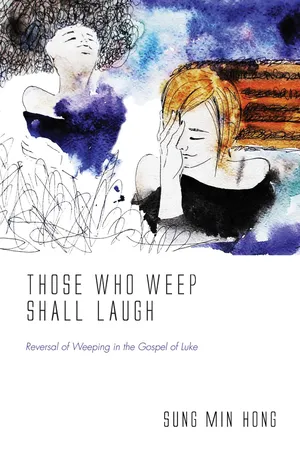![]()
CHAPTER ONE
HISTORY OF RESEARCH AND METHODOLOGY
This chapter is a survey of previous materials that discuss reversal in the Gospel of Luke. Because of the paucity of studies concerning the reversal of weeping, this survey will focus on the context of the poor and rich, which is the most frequently treated category in the study of reversal. This chapter also discusses two main methods of criticism, composition and narrative criticism, which I will employ throughout the study. In addition, Luke’s purpose for using repetition, frequently noted by narrative critics, is his way of intensifying the theme of the reversal of weeping.
History of Research
Studies of reversal in Luke have focused on the reversal of rich and poor because, as John Nolland says, “Hunger and weeping are not being considered as separate conditions from poverty but as characteristic manifestations of poverty.” David Garland agrees: “The hungry and those beset by grief are subgroups of the poor.” Amanda C. Miller explains that the reversal is not separable from the schema of poor and rich: “Closely related to the ethics of wealth, poverty, and possessions in the Gospel of Luke is the theme of status reversal, the idea that the current power structure and values of this world will be turned upside down by the reign of God.” As a result, scholars have tended to subsume all other reversals under the category of poverty and wealth.
With this tendency, the previous attention to reversal has taken the following four focuses: (1) passing comments about the significance of reversal without consistent attention on reversal itself; (2) discussion of the reversal theme in relation to literary concerns; (3) treatment of reversal as a distinctive Lukan theme; and (4) discussion of reversal in the context of an apocalyptic motif.
Observations about Reversal
In most of the passing comments about reversal in the Gospel of Luke, the emphasis falls on three significant passages in which the reversal theme is explicitly shown: the Magnificat, the parable of the Rich Man and Lazarus, and the Beatitudes and Woes.
First to be considered here is the Magnificat. The reversal theme is clearly found in 1:52–53, which read, καθεῖλεν δυνάστας ἀπὸ θρόνων καὶ ὕψωσεν ταπεινούς, πεινῶντας ἐνέπλησεν ἀγαθῶν καὶ πλουτοῦντας ἐξαπέστειλεν κενούς. A sharp contrast is shown between δυνάστας and ταπεινούς in v. 52. It is God who exalts those who are in humble status (ταπεινούς), while He puts down the mighty (δυνάστας). Also πεινῶντας and πλουτοῦντας in v. 53 shows another contrast by reversal of fortune: Those who are hungry are full, whereas the rich are sent away empty. Many have recognized that the reversal is a significant component, especially in these two verses. Robert Tannehill says, “In its dynamic unity this text holds together the small and great, the birth of a baby to an unimportant woman and the fulfillment of Israel’s promise through the overturn of human society. By means of the text what would otherwise appear ordinary and insignificant becomes great with significance.” John Drury agrees, pointing out that it is one of Luke’s peculiar traits to illustrate “God’s classical action of raising the low and bringing down the lofty.” Tannehill’s interest is in the repetitive pattern (or contrast) within the Magnificat that contributes to the dynamic unity of the whole narrative of Luke, while Drury treats the theme of reversal in the context of Luke’s use of the Old Testament, not in the context of the poor and rich. Although neither scholar focuses explicitly on reversal per se, both notice that reversal is an important component in the Magnificat.
Richard Hays views reversal in the Magnificat as part of the fulfillment of Deuteronomistic command and the ethics of God’s renewed people. “Luke . . . proclaims God’s liberating power on behalf of the poor and hungry (Luke 1:52–53, 4:18–19) and highlights the vision for a new community of believers who share all possessions in common so that there are no poor among them, in fulfillment of the Deuteronomistic command.” Hays includes vv. 52–53 in the category of eschatological reversal and argues that the liberating power of God can make a new community for his renewed people. The renewed community of God’s people is marked by the sharing of their possessions with the poor.
Anke Inselmann understands the reversal as being on more a social and political level. “Bei aufmerksamer Lektüre wird dem impliziten Leser das Bild eines erhofften Messias mit politischen beziehungsweise eschatologischen Ansprüchen vermittelt. Wie in der Prophetie oder der weisheitlichen Psalmentradition zeigt sich die heilsgeschichtliche Wirkweise Gottes an politischen und sozialen irdischen Konsequenzen.” She rightly connects the verses to the tradition of the Psalms and points out that this OT tradition of God’s salvation results in political and social reversal. Both Hays’ and Inselmann’s analyses show that the reversal is not confined to the spiritual realm, but also happens in this present world. Thus, the Magnificat demon...
